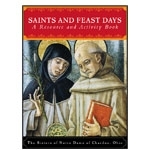Bernard of Montjoux
Feast day May 28

You probably know that cities are sometimes named after saints: St. Louis, St. Paul, San Francisco, San Antonio, to name a few. You know that people and parishes are given the names of patron saints. But did you know that Saint Bernard dogs are named for a real saint?

Bernard was a priest in the Northern Italian region of Aosta. This is a mountainous area where the Alps cross Italy, France, and Switzerland. For more than 40 years, he traveled throughout his diocese, visiting every mountainside village and valley. He celebrated Eucharist and Reconciliation with the people, gave instructions in the faith, built churches, and started schools. Everywhere he went he heard stories of travelers who had been lost in the mountains and frozen to death or been ambushed by robbers.
Today you can fly over the Alps or travel smoothly by rail or car. But back in the 11th century, people traveled on foot, on horseback, or in carts. Bernard saw a need, and he decided to do something about it. Bernard built two hospices for travelers where they could not find only shelter from the weather and safety from robbers, but a place to rest and eat. These hospices were located along two of the most frequently used routes, which were eventually named for Bernard—the Great St. Bernard Pass and the Little St. Bernard Pass. He brought Augustinian monks to run the hospices, and they built a monastery in the mountains. Every morning a patrol went out to look for travelers who were lost or injured and brought them back to the hospital. It was the monks who eventually bred the large, fury dogs—now called Saint Bernards—to help them find and rescue lost travelers.
In 1923 Pope Pius XI named Saint Bernard the patron of Alpinists and mountain climbers, and he is also claimed by skiers.

from Saints and Feast Days, by Sisters of Notre Dame of Chardon, Ohio
Image credit: Saint Bernard slaying the dragon on the outskirts of the Priory of Meillerie by A.R.P. Meillerie, date unknown. Public Domain via Wikimedia.

